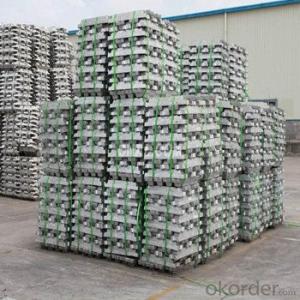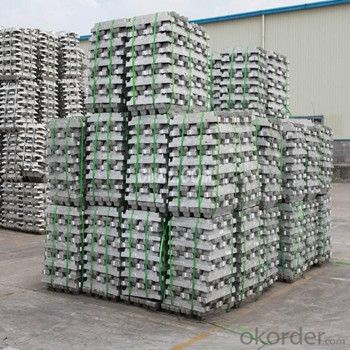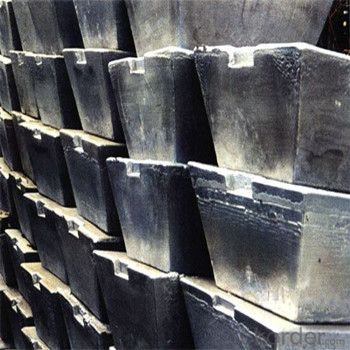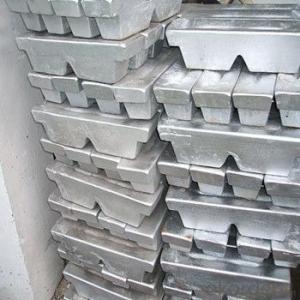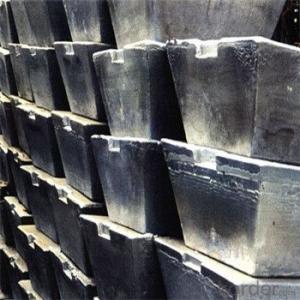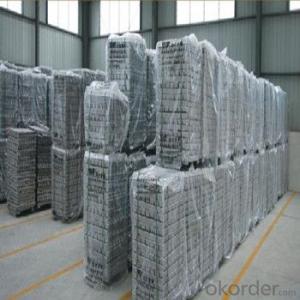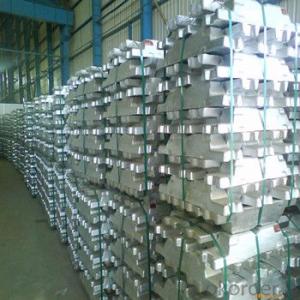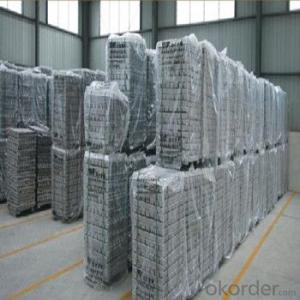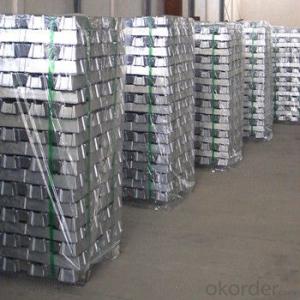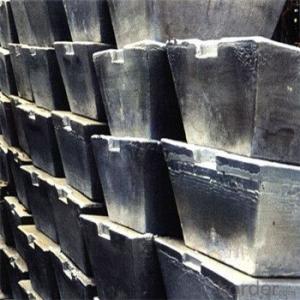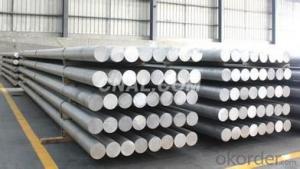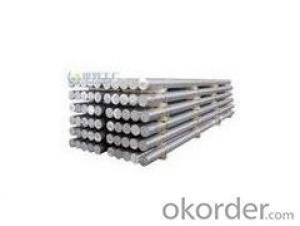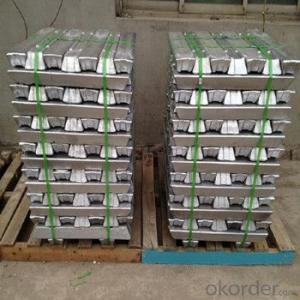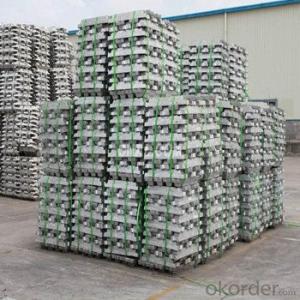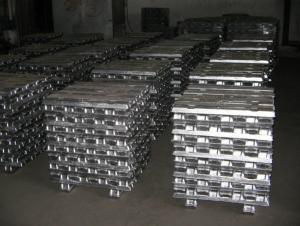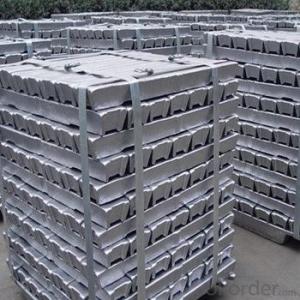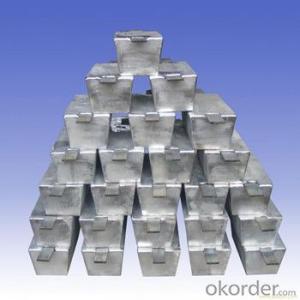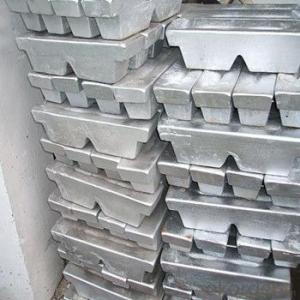Aluminum Ingot for Your Choice from China
- Loading Port:
- China main port
- Payment Terms:
- TT OR LC
- Min Order Qty:
- 1000 m.t.
- Supply Capability:
- 10000 m.t./month
OKorder Service Pledge
OKorder Financial Service
You Might Also Like
Pure Aluminum Ingot Used for Industry
1.Structure of Aluminum Ingot Description
Aluminum Ingot is with the AL as the main chemical composition. Aluminum Ingot is used for industry,such as automobile,pinning and weaving,electron broadly and so on.Aluminum Ingot has the following advantages: easy control and operation, fast melting.
2.Main Features of the Aluminum Ingot
•High Purity
•Easy control and operation
•High strength
•Fast melting
•Competitive price
•Best Service
3. Aluminum Ingot Images
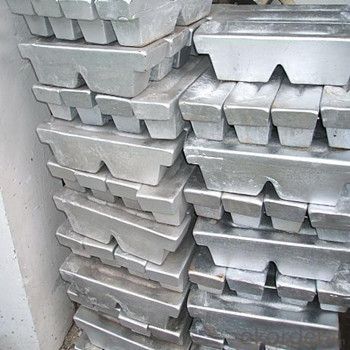
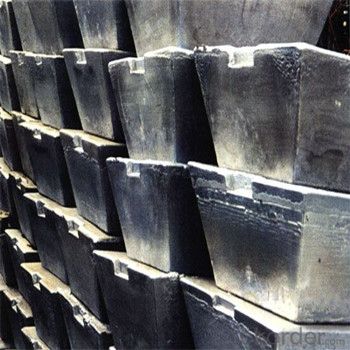
4. Aluminum Ingot Specification
Grade | Chemical Composition % | |||||||||
Al≥ | impurities ≤ | |||||||||
Si | Fe | Cu | Ga | Mg | Zn | Mn | others | Sum | ||
Al99.9 | 99.90 | 0.50 | 0.07 | 0.005 | 0.02 | 0.01 | 0.025 | - | 0.010 | 0.10 |
Al99.85 | 99.85 | 0.80 | 0.12 | 0.005 | 0.03 | 0.02 | 0.030 | - | 0.015 | 0.15 |
Al99.7 | 99.70 | 0.10 | 0.20 | 0.010 | 0.03 | 0.02 | 0.030 | - | 0.030 | 0.30 |
Al99.6 | 99.60 | 0.16 | 0.25 | 0.010 | 0.03 | 0.03 | 0.030 | - | 0.030 | 0.40 |
Al99.5 | 99.50 | 0.22 | 0.30 | 0.020 | 0.03 | 0.05 | 0.050 | - | 0.030 | 0.50 |
Al99.00 | 99.00 | 0.42 | 0.50 | 0.020 | 0.03 | 0.05 | 0.050 | - | 0.050 | 1.00 |
5.FAQ of Aluminum Ingot
We have organized several common questions for our clients,may help you sincerely:
①How about your company?
A world class manufacturer & supplier of castings forging in carbon steel and alloy steel,is one of the large-scale professional investment casting production bases in China,consisting of both casting foundry forging and machining factory. Annually more than 8000 tons Precision casting and forging parts are exported to markets in Europe,America and Japan. OEM casting and forging service available according to customer’s requirements.
②How to guarantee the quality of the products?
We have established the international advanced quality management system,every link from raw material to final product we have strict quality test;We resolutely put an end to unqualified products flowing into the market. At the same time, we will provide necessary follow-up service assurance.
③How long can we receive the product after purchase?
In the purchase of product within three working days, We will arrange the factory delivery as soon as possible. The pecific time of receiving is related to the state and position of customers.Commonly 7 to 10 working days can be served.
- Q: Can aluminum ingots be used in medical applications?
- Yes, aluminum ingots can be used in medical applications. Aluminum is a versatile metal that offers numerous advantages for medical devices and applications. Its lightweight nature, corrosion resistance, and excellent thermal conductivity make it an ideal choice for various medical equipment and instruments. Aluminum ingots can be used in the manufacturing of medical devices such as prosthetics, orthopedic implants, and surgical instruments. These ingots can be processed into precise shapes and sizes to meet the specific requirements of medical applications. Aluminum is also commonly used in the fabrication of medical equipment like MRI machines, X-ray machines, and dental tools. Additionally, aluminum ingots can be used in the production of medical packaging materials. Aluminum foils are often employed for packaging pharmaceutical products, as they provide a barrier against moisture, light, and oxygen, ensuring the integrity and longevity of the medications. It is important to note that the use of aluminum in medical applications should comply with strict regulations and guidelines to ensure patient safety. Manufacturers must adhere to stringent quality control measures and conduct thorough testing to guarantee the biocompatibility and safety of the final product. In conclusion, aluminum ingots can indeed be used in various medical applications due to their favorable properties. However, it is crucial to ensure compliance with applicable regulations and standards to guarantee the safety and effectiveness of the final medical product.
- Q: What are the main components of aluminum ingots?
- The main components of aluminum ingots are primarily aluminum metal, with trace amounts of impurities. Aluminum ingots are made by smelting aluminum ore, typically bauxite, which contains aluminum oxide. The ore is processed to extract the aluminum oxide, which is then refined and melted down to form ingots. These ingots are typically composed of 99% or more pure aluminum, with the remaining percentage consisting of impurities such as silicon, iron, copper, magnesium, and other elements. The exact composition of impurities may vary depending on the specific production process and the quality of the raw materials used. However, the high purity of aluminum ingots ensures their suitability for various industrial applications, including the manufacturing of various aluminum products.
- Q: What kind of aluminum consumption does the furnace compare with natural gas?
- Oil, of course, because the aluminum has a low melting point
- Q: The difference between pure aluminium ingot and aluminium alloy ingotToday I know, aluminum ingot is also divided into pure aluminum ingot, aluminum alloy ingot, what is the difference between them?
- Pure aluminium ingot: Aluminum exists in the surface, in addition to iron (Fe) in ranking the second metal elements, since the electrolysis method was invented, human made from bauxite surface, refining of high purity (more than 99.7%) for pure aluminum, aluminum ingots. Such as direct casting for casting toughness is good but not with strength, poor physical properties.
- Q: How are aluminum ingots protected from corrosion?
- Aluminum ingots are protected from corrosion through various methods such as applying a protective coating, using proper storage conditions, and employing corrosion inhibitors.
- Q: How are aluminum ingots tested for quality?
- Aluminum ingots are tested for quality through a series of quality control measures. These include visual inspections to check for any surface defects or impurities, measurements of dimensions and weight to ensure they meet the required specifications, and chemical composition analysis to verify the purity and alloy composition. Additionally, mechanical tests such as hardness and tensile strength assessments may be conducted to evaluate the ingot's structural integrity. These rigorous testing procedures ensure that only high-quality aluminum ingots are released for further processing and manufacturing.
- Q: How are impurities removed from aluminum ingots?
- Impurities are removed from aluminum ingots through a process called refining or purification. There are several methods used to achieve this, including: 1. Fluxing: Fluxes, such as chlorine or sodium chloride, are added to the molten aluminum to react with the impurities. This process forms compounds that are more easily removed as slag or dross. 2. Electrolytic refining: In this method, the impure aluminum ingots are immersed in an electrolyte solution and subjected to an electric current. The impurities are attracted to the anode, where they accumulate as a residue, while the purified aluminum collects at the cathode. 3. Centrifugal separation: This technique involves spinning the molten aluminum in a centrifuge, which causes the denser impurities to migrate towards the outer edge. The purified aluminum is then collected from the center. 4. Filtration: Filtration can be used to remove solid impurities from the molten aluminum. Filters made of materials like ceramic or graphite are employed, which trap the impurities while allowing the purified aluminum to pass through. 5. Vacuum treatment: In this method, the molten aluminum is subjected to a vacuum environment, which helps to remove volatile impurities like hydrogen and some low-boiling-point metals. The reduced pressure facilitates the removal of these impurities by vaporization. It is important to note that the specific method chosen for impurity removal depends on factors such as the type and concentration of impurities, the desired level of purity, and the cost-effectiveness of the chosen process. Different industries and applications may require different levels of purity, and thus, the refining process may vary accordingly.
- Q: Cost of material consumption of aluminium ingot
- In addition, there are fluoride salts, etc., but they account for a small cost, usually a ton of aluminum ingot production only consumed 200~300 yuan.
- Q: What is aluminium ingot? Is it different from other series of aluminum?
- The problem lies in the production process, the mold work with a problem, to the mold work belt repair, this you have to let manufacturers solve.
- Q: How to add zinc when producing aluminium ingot?
- Is expected to add amount of refined aluminum liquid the total weight of the existing x2%= aluminum liquid x weight of the existing zinc content + pure zinc (such as aluminum zinc alloy, but also to calculate the pure zinc alloy for many, after the completion of the calculation), zinc into liquid aluminum can melt mixing.
Send your message to us
Aluminum Ingot for Your Choice from China
- Loading Port:
- China main port
- Payment Terms:
- TT OR LC
- Min Order Qty:
- 1000 m.t.
- Supply Capability:
- 10000 m.t./month
OKorder Service Pledge
OKorder Financial Service
Similar products
Hot products
Hot Searches
Related keywords
